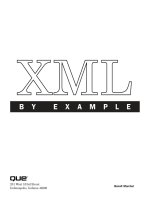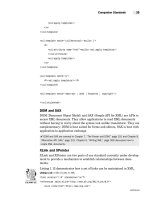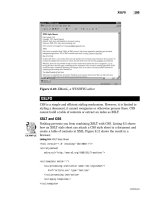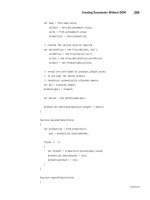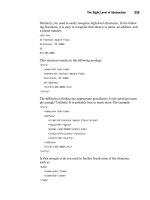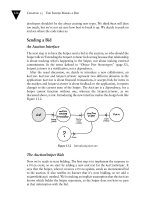Tài liệu XML by Example- P4 pdf
Bạn đang xem bản rút gọn của tài liệu. Xem và tải ngay bản đầy đủ của tài liệu tại đây (638.7 KB, 50 trang )
Paths
The syntax for XML paths is similar to file paths. XML paths start from
the root of the document and list elements along the way. Elements are
separated by the “
/
” character.
The root of the document is “
/
”. The root is a node that sits before the top-
level element. It represents the document as a whole.
The following four paths match respectively the title of the article
(
<title>XML Style Sheets</title>
), the keywords of the article, the top-
most article element, and all sections in the article. Note that the last path
matches several elements in the source tree.
/article/title
/article/keywords
/article
/article/section
TIP
Note that “
/
” points to the immediate children of a node. Therefore,
/article/title
selects the main title of the article (XML Style Sheets), not all the titles below the arti-
cle element. It won’t select the section titles.
To select all the descendants from a node, use the “
//
” sequence.
/article//title
selects all the titles in the article. It selects the main title and the section titles.
In the style sheet, most paths don’t start at the root. XSL has the notion of
current element. Paths in the match attribute can be relative to the current
element.
Again, this is similar to the file system. Double-clicking the
accessories
folder in the
c:\program files
folder moves to
c:\program files\
accessories
folder, not to
c:\accessories
.
If the current element is an article, then
title
matches
/article/title
but if the current article is a section,
title
matches one of the
/article/
section/title
s.
To match any element, use the wildcard character “
*
”. The path
/article/*
matches any direct descendant from article, such as title, keywords, and
so on.
It is possible to combine paths in a match with the “
|
” character, such as
title | p
matches title or
p
elements.
135
Basic XSLT
EXAMPLE
07 2429 CH05 2.29.2000 2:21 PM Page 135
Please purchase PDF Split-Merge on www.verypdf.com to remove this watermark.
Matching on Attributes
Paths can match on attributes, too. The following template applies only to
“mailto” URLs:
<xsl:template match=”url[@protocol=’mailto’]”>
<A>
<xsl:attribute name=”HREF”>mailto:<xsl:apply-templates/>
</xsl:attribute>
<xsl:apply-templates/>
</A>
</xsl:template>
<A href=”mailto:”>
➥</A>
It matches
<url protocol=”mailto”></url>
that has a protocol attribute with the value “mailto” but it does not match
<url> />. The more generic
url
path would
match the later element.
url[@protocol]
matches URL elements that have a protocol attribute,
no matter what its value is. It would match the
<url
protocol=”http”>www.w3.org/Style</url>
but it would not match
<url> />.
Matching Text and Functions
Functions restrict paths to specific elements. The following two paths are
identical and select the text of the title of the second section in the docu-
ment (
Styling
).
/article/section[position()=2]/title/text()
/article/section[2]/title/text()
Most functions can also take a path as an argument. For example,
count(//title)
returns the number of title elements in the document.
Table 5.1 lists some of the most common functions.
Table 5.1: Most common XSL functions
XSL Function Description
position()
returns the position of the current node in the node set
text()
returns the text (the content) of an element
136
Chapter 5: XSL Transformation
EXAMPLE
OUTPUT
OUTPUT
07 2429 CH05 2.29.2000 2:21 PM Page 136
Please purchase PDF Split-Merge on www.verypdf.com to remove this watermark.
last()
returns the position of the last node in the current node set
count()
returns the number of nodes in the current node set
not()
negates the argument
contains()
returns true if the first argument contains the second argument
starts-with()
returns true if the first argument starts with the second argu-
ment
New functions are declared in JavaScript, Java, C++, and so on, with the
xsl:functions
element.
<xsl:template match=”/”>
<xsl:value-of select=”psol:today()”/>
</xsl:template>
<xsl:functions ns=”psol” type=”text/javascript”>
function today() {
return Date().toString()
}
</xsl:functions>
CAUTION
Be aware that this element was still very much in flux in the draft we used to prepare
this chapter.
Deeper in the Tree
After loading the style sheet, the XSL processor loads the source document.
Next, it walks through the source document from root to leaf nodes. At each
step it attempts to match the current node against a template.
If there is a match, the processor generates the nodes in the resulting tree.
When it encounters
xsl:apply-templates
, it moves to the children of the
current node and repeats the process; that is, it attempts to match them
against a template.
In other words,
xsl:apply-templates
is a recursive call to the style sheet.
A recursive approach is natural to manipulate trees. You might have recog-
nized a deep-first search algorithm. Figure 5.6 illustrates how it works.
137
Basic XSLT
XSL Function Description
EXAMPLE
07 2429 CH05 2.29.2000 2:21 PM Page 137
Please purchase PDF Split-Merge on www.verypdf.com to remove this watermark.
Figure 5.6: Walking down the input tree
Following the Processor
Let’s follow the XSL processor for the first few templates in the style sheet.
After loading the style sheet and the source document the processor posi-
tions itself at the root of the source document. It looks for a template that
matches the root and it immediately finds
<xsl:template match=”/”>
<HTML>
<HEAD>
<TITLE>Pineapplesoft Link</TITLE>
</HEAD>
<BODY>
<xsl:apply-templates/>
</BODY>
</HTML>
</xsl:template>
Because the root sits before the top-level element, it is ideal to create the
top-level element of the resulting tree. For HTML, it is the
HTML
element
with
HEAD
and
BODY
elements.
When it encounters
xsl:appy-templates
, the processor moves to the first
child of the current node. The first child of the root is the top-level element
or the article element.
The style sheet defines no templates for the article but can match template
against a built-in template. Built-in templates are not defined in the style
sheet. They are predefined by the processor.
138
Chapter 5: XSL Transformation
07 2429 CH05 2.29.2000 2:21 PM Page 138
Please purchase PDF Split-Merge on www.verypdf.com to remove this watermark.
<xsl:template match=”* | /”>
<xsl:apply-templates/>
</xsl:template>
NOTE
The built-in template does not modify the resulting tree (it does not create elements)
but it recursively calls the current element’s children.
Without the default template, there would be no rules to trigger the recursive matching
process and the processor would stop.
It is possible to override the built-in template, for example, to stop processing for ele-
ments not explicitly defined elsewhere:
<xsl:template match=”* | /”/>
The built-in template forces the processor to load the first children of
article, that is, the title element. The following template matches
<xsl:template match=”article/title”>
<P><B><xsl:apply-templates/></B></P>
</xsl:template>
Note that the processor matches on a relative path because the current
node is article. It creates a paragraph in the HTML document.
xsl:apply-
templates
loads title’s children.
The first and only child of title is a text node. The style sheet has no rule to
match text but there is another built-in template that copies the text in the
resulting tree.
<xsl:template match=”text()”>
<xsl:value-of select=”.”/>
</xsl:template>
The title’s text has no children so the processor cannot go to the next level.
It backtracks to the article element and moves to the next child: the date
element. This element matches the last template.
<xsl:template match=”abstract | date | keywords | copyright”/>
This template generates no output in the resulting tree and stops process-
ing for the current element.
The processor backtracks again to article and processes its other children:
copyright, abstract, keywords, and section. Copyright, abstract, and key-
words match the same rule as abstract and generate no output in the
resulting tree.
139
Basic XSLT
07 2429 CH05 2.29.2000 2:21 PM Page 139
Please purchase PDF Split-Merge on www.verypdf.com to remove this watermark.
The section element, however, matches the default template and the proces-
sor moves to its children, title, and
p
elements. The processor continues to
match rules with nodes until it has exhausted all the nodes in the original
document.
Creating Nodes in the Resulting Tree
Sometimes it is useful to compute the value or the name of new nodes. The
following template creates an HTML anchor element that points to the
URL. The anchor has two attributes. The first one,
TARGET
, is specified
directly in the template. However, the processor computes the second
attribute,
HREF
, when it applies the rule.
<xsl:template match=”url”>
<A TARGET=”_blank”>
<xsl:attribute name=”HREF”>
<xsl:apply-templates/>
</xsl:attribute>
<xsl:apply-templates/>
</A>
</xsl:template>
<A target=”_blank” href=” />➥ />Table 5.2 lists other XSL elements that compute nodes in the resulting tree.
Table 5.2: XSL elements to create new objects
XSL Element Description
xsl:element
creates element with a computed name
xsl:attribute
creates attribute with a computed value
xsl:attribute-set
conveniently combines several xsl:attributes
xsl:text
creates a text node
xsl:processing-instruction
creates a processing instruction
xsl:comment
creates a comment
xsl:copy
copies the current node
xsl:value-of
computes text by extracting from the source tree or
inserting a variable
xsl:if
instantiates its content if the expression is true
xsl:choose
selects elements to instantiate among possible
alternatives
xsl:number
creates formatted number
140
Chapter 5: XSL Transformation
EXAMPLE
OUTPUT
07 2429 CH05 2.29.2000 2:21 PM Page 140
Please purchase PDF Split-Merge on www.verypdf.com to remove this watermark.
P
RIORITY
There are rules to prioritize templates. Without going into too many details,
templates with more specific paths take precedence over less specific tem-
plates. In the following example, the first template has a higher priority
than the second template because it matches an element with a specific
attribute.
<xsl:template match=”url[@protocol=’mailto’]”>
<A>
<xsl:attribute name=”HREF”>mailto:<xsl:apply-templates/>
</xsl:attribute>
<xsl:apply-templates/>
</A>
</xsl:template>
<xsl:template match=”url”>
<A TARGET=”_blank”>
<xsl:attribute name=”HREF”>
<xsl:apply-templates/>
</xsl:attribute>
<xsl:apply-templates/>
</A>
</xsl:template>
If there is a conflict between two templates of equivalent priority, then the
XSL processor can either report an error or choose the template that
appears last in the style sheet.
Supporting a Different Medium
Recall that my original problem is to provide both an HTML and a text ver-
sion of the document. We have seen how to automatically create an HTML
version document, now it’s time to look at the text version.
Text Conversion
CAUTION
Text conversion stretches the concept of XML to XML conversion; therefore, you have to
be careful in writing the style sheet.
Listing 5.4 is the text style sheet. It is very similar to the previous style
sheet except that it inserts only text nodes, no XML elements, in the
resulting tree.
141
Supporting a Different Medium
EXAMPLE
EXAMPLE
07 2429 CH05 2.29.2000 2:21 PM Page 141
Please purchase PDF Split-Merge on www.verypdf.com to remove this watermark.
Listing 5.4: A Style Sheet to Produce a Text File
<?xml version=”1.0” encoding=”ISO-8859-1”?>
<xsl:stylesheet
xmlns:xsl=” /><xsl:output method=”text”/>
<xsl:template match=”article/title”>
<xsl:text>=== </xsl:text>
<xsl:apply-templates/>
<xsl:text> ===</xsl:text>
</xsl:template>
<xsl:template match=”section/title”>
<xsl:text>*** </xsl:text>
<xsl:apply-templates/>
<xsl:text> ***</xsl:text>
</xsl:template>
<xsl:template match=”url”>
<xsl:text>[</xsl:text>
<xsl:apply-templates/>
<xsl:text>]</xsl:text>
</xsl:template>
<xsl:template match=”p”>
<xsl:text>
</xsl:text>
<xsl:apply-templates/>
</xsl:template>
<xsl:template match=”abstract | date | keywords | copyright”/>
</xsl:stylesheet>
Logically enough, the
xsl:stylesheet
element does not declare a name-
space for the resulting tree. This style sheet also makes heavy use of text
nodes.
142
Chapter 5: XSL Transformation
07 2429 CH05 2.29.2000 2:21 PM Page 142
Please purchase PDF Split-Merge on www.verypdf.com to remove this watermark.
<xsl:template match=”section/title”>
<xsl:text>*** </xsl:text>
<xsl:apply-templates/>
<xsl:text> ***</xsl:text>
</xsl:template>
The following command line creates the text in Listing 5.5.
java –classpath
➥c:\lotusxsl\xerces.jar;c:\lotusxs\lotusxsl.jar
➥com.lotus.xsl.Process
➥-in 19990101_xsl.xml
➥-xsl email.xsl -out 19990101_xsl.txt
Listing 5.5: The Resulting Text Document
=== XML Style Sheets ===
Send comments and suggestions to <>.
*** Styling ***
Style sheets are inherited from SGML, an XML ancestor. Style sheets originated
➥in publishing and document management applications. XSL is XML’s standard style
➥sheet, see [ />*** How XSL Works ***
An XSL style sheet is a set of rules where each rule specifies how to format
➥certain elements in the document. To continue the example from the previous
➥section, the style sheets have rules for title, paragraphs and keywords.
With XSL, these rules are powerful enough not only to format the document
➥but also to reorganize it, e.g. by moving the title to the front page or
➥extracting the list of keywords. This can lead to exciting applications of XSL
➥outside the realm of traditional publishing. For example, XSL can be used to
➥convert documents between the company-specific markup and a standard one.
*** The Added Flexibility of Style Sheets ***
Style sheets are separated from documents. Therefore one document can have more
➥than one style sheet and, conversely, one style sheet can be shared amongst
➥several documents.
This means that a document can be rendered differently depending on the media or
➥the audience. For example, a “managerial” style sheet may present a summary
➥view of a document that highlights key elements but a “clerical” style sheet
➥may display more detailed information.
143
Supporting a Different Medium
OUTPUT
07 2429 CH05 2.29.2000 2:21 PM Page 143
Please purchase PDF Split-Merge on www.verypdf.com to remove this watermark.
Customized Views
Currently, most people access the Web through a browser on a Windows
PC. Some people use Macintoshes, others use UNIX workstations. This will
change in the future as more people turn to specialized devices. Already
WebTV has achieved some success with a browser in a TV set.
Mobile phones and PDAs, such as the popular PalmPilot, will be increas-
ingly used for Web browsing. Ever tried surfing on a PalmPilot? It works
surprisingly well but, on the small screen, many Web sites are not readable
enough.
One solution to address the specific needs of smaller devices might be to
use XHTML, an XML simplified version of HTML. XHTML is based on
HTML but it has an XML syntax (as opposed to an SGML syntax). It is also
designed to be modular as it is expected smaller devices will implement
only a subset of the recommendation.
According to the W3C, these new platforms might account for up to 75% of
Web viewing by the year 2002. What can you do about it? Will you have to
maintain several versions of your Web site: one for existing Web browsers
and one for each new device with its own subset?
XSL to the rescue! It will be easy to manage the diversity of browsers and
platforms by maintaining the document source in XML and by converting
to the appropriate XHTML subset with XSLT. In essence, this is how I
manage the e-zine. Figure 5.7 illustrates how this works.
144
Chapter 5: XSL Transformation
Figure 5.7: Maintain one XML document and convert it to the appropriate
markup language.
07 2429 CH05 2.29.2000 2:21 PM Page 144
Please purchase PDF Split-Merge on www.verypdf.com to remove this watermark.
Where to Apply the Style Sheet
So far, we have converted the XML documents before publishing them. The
client never sees XML; it manipulates only HTML.
Today, this is the realistic option because few users have an XML-enabled
browser such as Internet Explorer 5.0 or a beta version of Mozilla 5.0
(Mozilla is the open source version of Netscape Communicator).
Furthermore, the XSL recommendation is not final yet so implementations
of XSL processors are not always compatible with one another.
Yet, if your users have XML-enabled browsers, it is possible to send them
raw XML documents and style sheets. The browser dynamically applies the
style sheets and renders the documents. Figure 5.8 contrasts the two
options.
145
Where to Apply the Style Sheet
Figure 5.8: Style sheets on the server or on the client
Internet Explorer 5.0
CAUTION
Because XSL is still in draft, browser implementations are not compatible. The material
in this section works with Internet Explorer 5.0, which implements an early draft of XSL
and is not compatible with the current draft, much less with the future recommenda-
tion.
The processing instruction
xml-stylesheet
associates a style sheet with the
current document. It takes two parameters, an href to the style sheet and
the type of the style sheet (text/xsl, in this case).
<?xml-stylesheet href=”simple-ie5.xsl” type=”text/xsl”?>
Listing 5.6 is the XML document with the appropriate processing instruc-
tion for Internet Explorer 5.0.
Listing 5.6: The XML Document Prepared for Internet Explorer 5.0
<?xml version=”1.0”?>
<?xml-stylesheet href=”simple-ie5.xsl” type=”text/xsl”?>
EXAMPLE
continues
07 2429 CH05 2.29.2000 2:21 PM Page 145
Please purchase PDF Split-Merge on www.verypdf.com to remove this watermark.
Listing 5.6: continued
<article fname=”19990101_xsl”>
<title>XML Style Sheets</title>
<date>January 1999</date>
<copyright>1999, Benoît Marchal</copyright>
<abstract>Style sheets add flexibility to document viewing.</abstract>
<keywords>XML, XSL, style sheet, publishing, web</keywords>
<section>
<p>Send comments and suggestions to <url protocol=”mailto”>bmarchal@
➥pineapplesoft.com</url>.</p>
</section>
<section>
<title>Styling</title>
<p>Style sheets are inherited from SGML, an XML ancestor. Style sheets
➥originated in publishing and document management applications. XSL is XML’s
➥standard style sheet, see <url> /></section>
<section>
<title>How XSL Works</title>
<p>An XSL style sheet is a set of rules where each rule specifies how to format
➥certain elements in the document. To continue the example from the previous
➥section, the style sheets have rules for title, paragraphs and keywords.</p>
<p>With XSL, these rules are powerful enough not only to format the document
➥but also to reorganize it, e.g. by moving the title to the front page or
➥extracting the list of keywords. This can lead to exciting applications of XSL
➥outside the realm of traditional publishing. For example, XSL can be used to
➥convert documents between the company-specific markup and a standard one.</p>
</section>
<section>
<title>The Added Flexibility of Style Sheets</title>
<p>Style sheets are separated from documents. Therefore one document can have
➥more than one style sheet and, conversely, one style sheet can be shared
➥amongst several documents.</p>
<p>This means that a document can be rendered differently depending on the media
➥or the audience. For example, a “managerial” style sheet may present a summary
➥view of a document that highlights key elements but a “clerical” style sheet
➥may display more detailed information.</p>
</section>
</article>
Furthermore, the style sheet must be adapted to the older version of XSL
that Internet Explorer supports. Listing 5.7 is the adapted style sheet.
Figure 5.9 shows the result in Internet Explorer.
146
Chapter 5: XSL Transformation
07 2429 CH05 2.29.2000 2:21 PM Page 146
Please purchase PDF Split-Merge on www.verypdf.com to remove this watermark.
Listing 5.7: XSLT Style Sheet for Internet Explorer 5.0
<?xml version=”1.0” encoding=”ISO-8859-1”?>
<xsl:stylesheet
xmlns:xsl=” />xmlns=” />>
<xsl:template match=”*”>
<xsl:apply-templates/>
</xsl:template>
<xsl:template match=”text()”>
<xsl:value-of select=”.”/>
</xsl:template>
<xsl:template match=”/”>
<HTML>
<HEAD>
<TITLE>Pineapplesoft Link</TITLE>
</HEAD>
<BODY>
<xsl:apply-templates/>
</BODY>
</HTML>
</xsl:template>
<xsl:template match=”section/title”>
<P><I><xsl:apply-templates/></I></P>
</xsl:template>
<xsl:template match=”article/title”>
<P><B><xsl:apply-templates/></B></P>
</xsl:template>
<xsl:template match=”url”>
<A TARGET=”_blank”>
<xsl:attribute name=”href”>
<xsl:apply-templates/>
</xsl:attribute>
<xsl:apply-templates/>
</A>
147
Where to Apply the Style Sheet
continues
07 2429 CH05 2.29.2000 2:21 PM Page 147
Please purchase PDF Split-Merge on www.verypdf.com to remove this watermark.
Listing 5.7: continued
</xsl:template>
<xsl:template match=”url[@protocol=’mailto’]”>
<A>
<xsl:attribute name=”href”>mailto:<xsl:apply-templates/>
</xsl:attribute>
<xsl:apply-templates/>
</A>
</xsl:template>
<xsl:template match=”p”>
<P><xsl:apply-templates/></P>
</xsl:template>
<xsl:template match=”abstract | date | keywords | copyright”/>
</xsl:stylesheet>
148
Chapter 5: XSL Transformation
OUTPUT
Figure 5.9: Internet Explorer 5.0 renders XML.
Changes to the Style Sheet
The style sheet has been adapted in two places. First, the XSL namespace
points to an earlier version of XSL.
07 2429 CH05 2.29.2000 2:21 PM Page 148
Please purchase PDF Split-Merge on www.verypdf.com to remove this watermark.
<xsl:stylesheet
xmlns:xsl=” />xmlns=” />>
Second, Internet Explorer has no built-in templates. They must be declared
explicitly in the style sheet.
<xsl:template match=”*”>
<xsl:apply-templates/>
</xsl:template>
<xsl:template match=”text()”>
<xsl:value-of select=”.”/>
</xsl:template>
CAUTION
Internet Explorer 5.0 does not use the standard priority rules. Therefore, the default
templates must be at the top of the style sheet; otherwise, they would have higher
priority than our rules.
Advanced XSLT
XSLT is a powerful transformation mechanism. So far, we have only used a
subset of it. Our resulting document follows a structure that is close to the
original document. Elements might have been added or removed from the
tree but they are not reorganized.
Yet, it is often useful to reorganize completely the source document. For
example, we might want to create a table of contents at the beginning of
the document.
This is possible with the
xsl:value-of
element.
xsl:value-of
inserts arbi-
trary elements from the source tree anywhere in the resulting tree.
Listing 5.8 is a more sophisticated style sheet that, among other things,
creates a table of contents.
Listing 5.8: A More Powerful XSLT Style Sheet
<?xml version=”1.0” encoding=”ISO-8859-1”?>
<!DOCTYPE xsl:stylesheet [
<!ENTITY copy “©”>
]>
<xsl:stylesheet
xmlns:xsl=” />149
Advanced XSLT
EXAMPLE
continues
07 2429 CH05 2.29.2000 2:21 PM Page 149
Please purchase PDF Split-Merge on www.verypdf.com to remove this watermark.
Listing 5.8: continued
xmlns=” /><xsl:output method=”html”/>
<xsl:template match=”/”>
<HTML>
<HEAD>
<TITLE><xsl:call-template name=”title”/></TITLE>
<META NAME=”keywords”>
<xsl:attribute name=”CONTENT”>
<xsl:value-of select=”article/keywords”/>,
</xsl:attribute>
</META>
</HEAD>
<BODY>
<P><B><xsl:call-template name=”title”/></B></P>
<P><B>Table of Contents</B></P>
<UL>
<xsl:for-each select=”article/section/title”>
<LI><A>
<xsl:attribute name=”HREF”>
➥#<xsl:value-of select=”generate-id()”/>
</xsl:attribute>
<xsl:value-of select=”.”/>
</A></LI>
</xsl:for-each>
</UL>
<xsl:apply-templates/>
<P>Copyright © <xsl:value-of select=”article/copyright”/></P>
</BODY>
</HTML>
</xsl:template>
<xsl:template name=”title”>
<xsl:value-of select=”/article/title”/> (
<xsl:value-of select=”/article/date”/> )
</xsl:template>
150
Chapter 5: XSL Transformation
07 2429 CH05 2.29.2000 2:21 PM Page 150
Please purchase PDF Split-Merge on www.verypdf.com to remove this watermark.
<xsl:template match=”section/title”>
<P><I><A>
<xsl:attribute name=”NAME”>
<xsl:value-of select=”generate-id()”/>
</xsl:attribute>
<xsl:apply-templates/>
</A></I></P>
</xsl:template>
<xsl:template match=”url”>
<A TARGET=”_blank”>
<xsl:attribute name=”href”>
<xsl:value-of select=”.”/>
</xsl:attribute>
<xsl:value-of select=”.”/>
</A>
</xsl:template>
<xsl:template match=”url[@protocol=’mailto’]”>
<A>
<xsl:attribute name=”href”>mailto:<xsl:value-of select=”.”/>
</xsl:attribute>
<xsl:value-of select=”.”/>
</A>
</xsl:template>
<xsl:template match=”p”>
<P><xsl:apply-templates/></P>
</xsl:template>
<xsl:template match=”article/title | abstract | date |
keywords | copyright”/>
</xsl:stylesheet>
151
Advanced XSLT
07 2429 CH05 2.29.2000 2:21 PM Page 151
Please purchase PDF Split-Merge on www.verypdf.com to remove this watermark.
You can use LotusXSL to apply this style sheet. It generates the HTML doc-
ument in Listing 5.9. Figure 5.10 shows the result in a browser.
Listing 5.9: The Resulting HTML Document
<!DOCTYPE html PUBLIC “-//W3C//DTD HTML 4.0 Transitional//EN”>
<HTML>
<HEAD>
<TITLE>XML Style Sheets ( January 1999 )</TITLE>
<META name=”keywords” content=”XML, XSL, style sheet, publishing, web”>
</HEAD>
<BODY>
<P><B>XML Style Sheets ( January 1999 )</B></P>
<P><B>Table of Contents</B></P>
<UL>
<LI><A href=”#N-614609527”>Styling</A></LI>
<LI><A href=”#N-634270327”>How XSL Works</A></LI>
<LI><A href=”#N-653406839”>The Added Flexibility of Style Sheets</A></LI>
</UL>
<P>Send comments and suggestions to <A
href=”mailto:”></A>.</P>
<P><I><A name=”N-614609527”>Styling</A></I></P>
<P>Style sheets are inherited from SGML, an XML ancestor. Style sheets
➥originated in publishing and document management applications. XSL is XML’s
➥standard style sheet, see <A target=”_blank”
➥href=” name=
➥”N-634270327”>How XSL Works</A></I></P>
<P>An XSL style sheet is a set of rules where each rule specifies how to format
➥certain elements in the document. To continue the example from the previous
➥section, the style sheets have rules for title, paragraphs and keywords.</P>
<P>With XSL, these rules are powerful enough not only to format the document
➥but also to reorganize it, e.g. by moving the title to the front page or
➥extracting the list of keywords. This can lead to exciting applications of XSL
➥outside the realm of traditional publishing. For example, XSL can be used to
➥convert documents between the company-specific markup and a standard one.</P>
<P><I><A name=”N-653406839”>The Added Flexibility of Style Sheets</A></I></P>
<P>Style sheets are separated from documents. Therefore one document can have
➥more than one style sheet and, conversely, one style sheet can be shared
➥amongst several documents.</P>
<P>This means that a document can be rendered differently depending on the media
➥or the audience. For example, a “managerial” style sheet may present a summary
➥view of a document that highlights key elements but a “clerical” style sheet
➥may display more detailed information.</P>
<P>Copyright ©1999, Benoît Marchal</P></BODY></HTML>
152
Chapter 5: XSL Transformation
OUTPUT
07 2429 CH05 2.29.2000 2:21 PM Page 152
Please purchase PDF Split-Merge on www.verypdf.com to remove this watermark.
Figure 5.10: The resulting HTML document in a browser
Declaring HTML Entities in a Style Sheet
This style sheet has an internal DTD to declare the
copy
entity—an
HTML entity. HTML has many entities that XML does not recognize.
<!DOCTYPE xsl:stylesheet [
<!ENTITY copy “©”>
]>
Reorganizing the Source Tree
The list of keywords must appear in an HTML
META
element. The following
example extracts the keywords from the source tree, with the
xsl:value-of
element.
<META NAME=”keywords”>
<xsl:attribute name=”CONTENT”>
<xsl:value-of select=”article/keywords”/>,
</xsl:attribute>
</META>
<META name=”keywords” content=”XML, XSL, style sheet, publishing, Web”>
CAUTION
Because select points to any element in the source tree, paths tend to be longer
than for the match attribute. It is common to spell out a path from root to element.
153
Advanced XSLT
OUTPUT
EXAMPLE
OUTPUT
07 2429 CH05 2.29.2000 2:21 PM Page 153
Please purchase PDF Split-Merge on www.verypdf.com to remove this watermark.
Calling a Template
When the same styling instructions are used at different places, group
them in a named template. For example, titles appear in the HTML title
and in the body of the document.
<xsl:template name=”title”>
<xsl:value-of select=”/article/title”/> (
<xsl:value-of select=”/article/date”/> )
</xsl:template>
<!-- ... -->
<P><B><xsl:call-template name=”title”/></B></P>
This simplifies maintenance because changes to the title are localized in a
single template.
xsl:include
imports a style sheet into the current style sheet. The follow-
ing imports the
core.xsl
style sheet:
<xsl:include href=”core.xsl”/>
xsl:include
must be a direct child of
xsl:stylesheet
, it cannot appear in
xsl:template
for example.
Repetitions
Sometimes a path points to several elements. For example,
article/
section/title
points to the three section titles. To loop over the elements,
use
xsl:for-each
. The following rule builds a table of contents with section
titles:
<UL>
<xsl:for-each select=”article/section/title”>
<LI><A>
<xsl:attribute name=”HREF”>
➥#<xsl:value-of select=”generate-id()”/>
</xsl:attribute>
<xsl:value-of select=”.”/>
</A></LI>
</xsl:for-each>
</UL>
<UL>
<LI><A href=”#N-614609527”>Styling</A></LI>
<LI><A href=”#N-634270327”>How XSL Works</A></LI>
<LI><A href=”#N-653406839”>The Added Flexibility of Style Sheets</A></LI>
</UL>
154
Chapter 5: XSL Transformation
EXAMPLE
EXAMPLE
EXAMPLE
OUTPUT
07 2429 CH05 2.29.2000 2:21 PM Page 154
Please purchase PDF Split-Merge on www.verypdf.com to remove this watermark.
